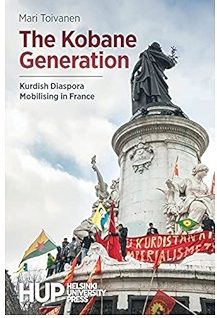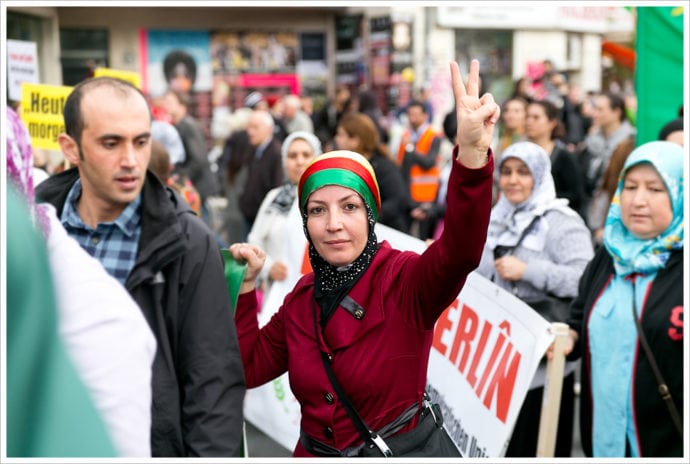
Kurds provide an interesting case study for the field of diaspora studies, as the Kurdish homeland is already fractured into territory belonging to four different nation-states: Iran, Iraq, Syria and Türkiye. This means that Kurdish identity is already transnational, existing through social and family networks, virtual spaces and political organizations that transcend national borders. The Kurdish diaspora in Europe is also multi-generational, as many immigrants in the mid-late 20th century arrived on work visas, and more recent arrivals coming as political asylees. The diaspora is also diverse in its loyalty to political parties, with some Kurds feeling closer to the philosophy of the YPG/J and their sister organization in Turkiye, the Partiya Karkerên Kurdistanê (Kurdish Workers Party/PKK) which advocates for local autonomous political units arranged into a transnational confederation, while others support Kurdish Nationalist groups, such as the Partiya Demokrat a Kurdistane (Kurdish Democratic Party/KDP), which governs the autonomous Kurdish Regional Government in Iraq. Some Kurds in the diaspora prefer not to associate with other entities, or with no formal political institutions at all.
The variety of opinions and identities within the Kurdish diaspora lead Toivanen to one of her most emphasized points, that diaspora groups cannot be reduced into clearly delineated categories. Methodological nationalism, the idea that nationality can be a main lens of analysis in sociological research, simply does not apply, as Kurds do not share a common nationality. Nor can Kurds be boiled down to one exact ethnic, linguistic or political group. Toivanen thus does away with the question of what a diaspora is, and instead asks “how did it come to be,” emphasizing diaspora as a network of relationships and practices.
Of particular interest is the idea of generation. The book opens with the question of whether second generation diaporans, those who were born to immigrant parents in a “hostland” consider their own relationship with the Kurdish “homeland.” Rather than simply consider the binary between the “first” and “second” generations of migration, Toivanen further considers the impact of political, social and technological trends on diasporans of different ages, and how actions within the diaspora radiate out and become touchpoints for both the Kurds back home, and the societies surrounding diasporans. In this way, she suggests that second generation Kurds in Europe are “raised in a transnational diaspora space but not limited to it.”
As previously mentioned, Toivanen writes with the goal of pushing past a groupist or nationalist bias in ethnographic research. She emphasizes repeatedly that diasporas are not defined populations that can be quantified or reduced to a set of common denominators.
To explain exactly what she means by this, Toivanen turns to the influences on second generation diasporans beyond their ethnic and familial identities. She notes that Kurds who were born is France often have a much better sense for their parents in how to navigate and communicate with local political and civil society structures. While the first generation often engaged in political activities that brought Kurdish immigrants together, such as party meetings, protests, and protests, second generation Kurds often engage in activities that are less politically formal, but more open to their hostland peers, such as petitions and boycotts, film festivals, and educational events. Of particular interest is the way that digital media and organizing spaces both ignited a feeling of pride in young and second generation Kurds and allowed them to add to a digital record of Kurdish identity. Seemingly overnight, Kurdish guerillas became a cultural touchstone through the interest of emerging digital media. Some of the portrayal was sensationalized – what journalist could fail to be enthralled by the beautiful women of the YPJ gunning down the barbaric ISIS against the backdrop of a burning Mesopotamia? Yet the narrowness and simpleness of the coverage of Kobane also meant that for the first time ever, young Kurds were seeing themselves not only in their native transnational diaspora life, but in their native, transnational digital lives. This led one interviewee to speculate that before Kobane “we did not exist, but now we can say that being a Kurd is a pride.” By responding to news and expanding discussions on social media and online forums about Kurdish history and culture from the starting point of Kobane, second generation Kurds have also thrust Kurdishness into the digital world.
While the stated research focus of The Kobane Generation is on the interactions of diasporic practices and generational practices, Toivanen’s work also contains a larger message for her own sociologist and anthropologist colleagues, as well as those wishing to engage politically with the Kurdish diaspora. As previously mentioned, Toivanen writes with the goal of pushing past a groupist or nationalist bias in ethnographic research. She emphasizes repeatedly that diasporas are not defined populations that can be quantified or reduced to a set of common denominators. Rather, diasporas are a shifting set of practices and relationships. The inherent transnationalism of a diaspora is also just one influence on the behavior of individuals or smaller groups within the broader community.
Secondly, while Toivanen is explicitly not writing with the goal of critiquing European governments in their dealings with the Kurdish diaspora, the book conveys a certain frustration with the barriers to effective political action within a global system where political power still hews to the contours of nation-states. It’s a frustration that appears to be shared between the author and her interlocuters. While the siege of Kobane is a focal point of activism from the homeland, Toivanen repeatedly turns the resilience of activists and the difficulties in their mobilization due to the shifting sands of French relations with Kurdish institutions. While the west venerated the YPG/J as the frontline against ISIS, their sister organization in Turkey, the PKK, remained condemned as a terrorist organization. Despite the interest of prominent French politicians in Kurdish freedom and self-determination, including then-president Francois Hollande and former first lady Danielle Mitterand, the French and other European countries often failed to act when Kurdish-rights issued conflicted with their relationships with Middle Eastern governments. The thread of the book repeatedly turns back to the assassination of three Kurdish women activists, Sakine ‘Sara’ Cansiz, Fidan Dogan, and Leyla Soylemez, in the Kurdish Information Center in Paris’s 10th Arrondissement. The assassin, who was suspected to be a Turkish intelligence agent, died in custody and the trail was dropped, an act interpreted by Kurds as a betrayal and a capitulation to Turkish interests. While Kobane becomes the focus of how Kurdish identity and possibility are focused in a Kurdish geography, the assassinations in Paris show how forces in the homeland can mobilize or silence Kurds in the context of Europe.
The effect in The Kobane Generation is not to recommend a specific policy response from the French government, but to elaborate on the possibilities, the limitations, and the sense of urgency present in diaspora organizing. As all good researchers do, Toivanen concludes with a call for further questions about the interactions of diaspora and generation as ethnographic lenses, and the reader is also left to question their own notions about the mechanisms of diaspora mobilization, and how diasporas interact with other cross-cutting social and political forces.









